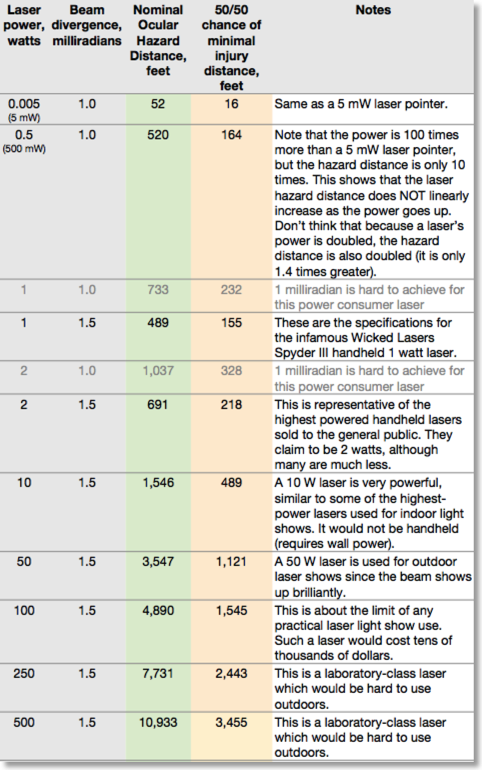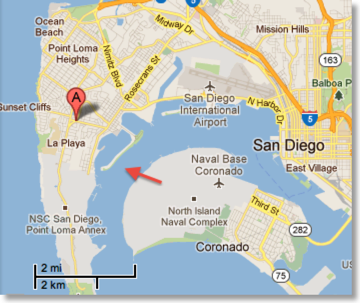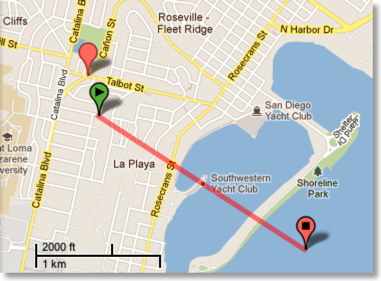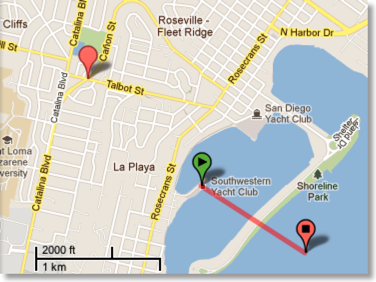Home
A comprehensive resource for safe and responsible laser use
US: UPDATED - San Diego harbor officers injured by laser
Two San Diego Harbor Police officers were injured by a green laser beam, while on routine patrol in Point Loma, at about 8:30 pm May 4 2012.
Officers Jennifer McMaster and Robert Twardy were patrolling near the Shelter Island Fishing Pier when both illuminated directly in their right eye. Twardy said “I noticed that I had a bright spot, like a residual flash that you kind of get when a camera flashes in your eye.” He suffered a “burning sensation”. Both officers were taken to UC San Diego Medical Center.
Twardy said that McMaster had a more direct hit, was in pain, and complained of blindness. She had possible burns to her retinas, and took time off to recover, according to the Los Angeles Times. She will make a full recovery, according to an NBC San Diego story. [See Update 1, at the bottom of this story after clicking the “Read More” link, for more medical information.]
Officers Jennifer McMaster and Robert Twardy were patrolling near the Shelter Island Fishing Pier when both illuminated directly in their right eye. Twardy said “I noticed that I had a bright spot, like a residual flash that you kind of get when a camera flashes in your eye.” He suffered a “burning sensation”. Both officers were taken to UC San Diego Medical Center.
Twardy said that McMaster had a more direct hit, was in pain, and complained of blindness. She had possible burns to her retinas, and took time off to recover, according to the Los Angeles Times. She will make a full recovery, according to an NBC San Diego story. [See Update 1, at the bottom of this story after clicking the “Read More” link, for more medical information.]
A Harbor Police assistant chief theorized the laser may have been used by an “amateur astronomer” pointing out features on the “supermoon” that evening, when the moon appears larger-than-normal in the sky. [See Update 2 below, where an astronomy expert says that there was an “almost perfect alignment” of the moon with the most probable laser path.]
The May 4 event was the first laser illumination of the San Diego Harbor Police. A helicopter search of the area did not turn up any suspects. Harbor Police are asking for the public’s help in finding the laser-wielding perpetrator.
From the Los Angeles Times, NBC San Diego (includes video news report with Officer Twardy), U-T San Diego
Below is a map of the general area. The “A” marker shows the general location of the laser source, while the red arrow points to the approximate location of the Harbor Police boat.
For visible, continuous-wave lasers, the eye injury damage potential at a distance is determined primarily by the laser’s output power and by the beam divergence (how tight the beam is). The laser’s color does not matter for eye injury potential, although it is vital for visual interference hazards such as causing glare or distraction.
A concept called the “Nominal Ocular Hazard Distance” is determined by these two factors of the laser power and the beam divergence. It should be further noted that the NOHD has a built-in 10 times safety factor. This means that the chance of getting even the smallest retinal lesion (burn) at the NOHD is practically impossible. As explained in the “Background information” section of this page, at about 1/3 of the NOHD there is a 50/50 chance that a person exposed to a laser under laboratory conditions could get the smallest medically detectable retinal lesion.
With that in mind, here is a chart of some laser powers, divergences, NOHD and the 50/50 chance of injury distance. Note that the higher the laser power, in general the larger the divergence. So we have given two divergence figures for some high-powered lasers, one for a very tight beam (possible with care and quality optics) and one for a more realistically larger divergence. In the chart below, the 1 milliradian rows are grayed out for the 1 and 2 watt lasers since it is very hard to get such a tight divergence in a relatively inexpensive consumer handheld laser.

The green column above represents the distance beyond which the laser is completely eye-safe, as determined by laser safety experts. The yellow column represents the approximate distance at which there is a 50/50 chance of causing a minimally detectable retinal burn, again as determined by laser safety experts.
Keep in mind the laser-to-boat distance was roughly 3,200 to 6,600 feet. It appears almost impossible for a consumer laser to cause an eye injury (retinal lesion or burn) at this distance, according to laser safety experts. It could cause bright light effects such as temporary flashblindness, temporary blind spots, or eye irritation.
For example, what if the laser was the most powerful handheld laser generally available to consumers? A nominal 2 watt laser, even if it had an extraordinarily tight 1 milliradian beam, would be eye-safe beyond 691 feet, and would have only a 50/50 chance of causing a minimal injury at 218 feet. But the laser was 4.6 times farther (safer) than the NOHD hazard distance, and was 14.7 times farther than the 50/50 injury chance distance.
Even a 10 watt visible continuous-wave laser, with a NOHD of 1,546 feet, would be completely eye safe at the San Diego laser-to-boat distances of somewhere between 3,200 feet and 6,600 feet. We are unaware of any handheld lasers over 2 watts being sold to consumers. It would be very unusual for someone who could afford a 10 watt laser to plug it in, and aim it recklessly as happened in San Diego.
Therefore, one or more of the following conclusions must be true:
It would be useful to have additional medical information about the eye injuries, and about the eye care experience of the person who examined the officers.
UPDATE 1, May 11 2012: A Harbor Police spokesperson told LaserPointerSafety.com that due to HIPAA medical privacy concerns, only general information can be released about the officers’ condition. Neither officer was permanently injured. The officers’ primary complaint was temporary flashblindness and afterimage. There was visible puffiness and irritation in at least one of the officers. One officer was diagnosed with a minor retinal burn. The medical and ophthalmologic experience of the person(s) who examined the officers is not known. Harbor Police understand that a retinal burn at the distances involved would require extraordinary conditions. They “are not married” to the idea that the laser caused eye damage. Their focus is on the laser causing disruption of the officers’ policing operations.
UPDATE 2, May 23 2012: An astronomy expert contacted by LaserPointerSafety.com said that the aiming-at-the-moon theory might be true. According to Mark Bennett, Observatory Director at the Miami Science Museum, “it’s almost a perfect alignment.” The moon as seen from San Diego on May 4th at 8:30 pm had the following parameters: Azimuth heading 127 degrees (southeast), 23 degrees altitude above the horizon, 98.5% illuminated (nearly a full moon). Bennett was working off of this map, which shows the most probable angle between the laser and the boat as a heavy green line.
The May 4 event was the first laser illumination of the San Diego Harbor Police. A helicopter search of the area did not turn up any suspects. Harbor Police are asking for the public’s help in finding the laser-wielding perpetrator.
From the Los Angeles Times, NBC San Diego (includes video news report with Officer Twardy), U-T San Diego
Analysis from LaserPointerSafety.com
Below is a map of the general area. The “A” marker shows the general location of the laser source, while the red arrow points to the approximate location of the Harbor Police boat.

Below is a close-up view. The laser source is the green triangle marker, the approximate boat location is the red square marker. The distance is about 1.25 miles, or 6,600 feet.

If the officers were mistaken about the laser location, and it was closer -- say, at the Southwestern Yacht Club -- the distance would be about 3,200 feet, as shown below:

What type of laser could cause retinal burns at 3,200-6,600 feet?
For visible, continuous-wave lasers, the eye injury damage potential at a distance is determined primarily by the laser’s output power and by the beam divergence (how tight the beam is). The laser’s color does not matter for eye injury potential, although it is vital for visual interference hazards such as causing glare or distraction.
A concept called the “Nominal Ocular Hazard Distance” is determined by these two factors of the laser power and the beam divergence. It should be further noted that the NOHD has a built-in 10 times safety factor. This means that the chance of getting even the smallest retinal lesion (burn) at the NOHD is practically impossible. As explained in the “Background information” section of this page, at about 1/3 of the NOHD there is a 50/50 chance that a person exposed to a laser under laboratory conditions could get the smallest medically detectable retinal lesion.
With that in mind, here is a chart of some laser powers, divergences, NOHD and the 50/50 chance of injury distance. Note that the higher the laser power, in general the larger the divergence. So we have given two divergence figures for some high-powered lasers, one for a very tight beam (possible with care and quality optics) and one for a more realistically larger divergence. In the chart below, the 1 milliradian rows are grayed out for the 1 and 2 watt lasers since it is very hard to get such a tight divergence in a relatively inexpensive consumer handheld laser.

The green column above represents the distance beyond which the laser is completely eye-safe, as determined by laser safety experts. The yellow column represents the approximate distance at which there is a 50/50 chance of causing a minimally detectable retinal burn, again as determined by laser safety experts.
Conclusions
Keep in mind the laser-to-boat distance was roughly 3,200 to 6,600 feet. It appears almost impossible for a consumer laser to cause an eye injury (retinal lesion or burn) at this distance, according to laser safety experts. It could cause bright light effects such as temporary flashblindness, temporary blind spots, or eye irritation.
For example, what if the laser was the most powerful handheld laser generally available to consumers? A nominal 2 watt laser, even if it had an extraordinarily tight 1 milliradian beam, would be eye-safe beyond 691 feet, and would have only a 50/50 chance of causing a minimal injury at 218 feet. But the laser was 4.6 times farther (safer) than the NOHD hazard distance, and was 14.7 times farther than the 50/50 injury chance distance.
Even a 10 watt visible continuous-wave laser, with a NOHD of 1,546 feet, would be completely eye safe at the San Diego laser-to-boat distances of somewhere between 3,200 feet and 6,600 feet. We are unaware of any handheld lasers over 2 watts being sold to consumers. It would be very unusual for someone who could afford a 10 watt laser to plug it in, and aim it recklessly as happened in San Diego.
Therefore, one or more of the following conclusions must be true:
- Officer McMaster did not have a retinal injury due to the May 4 laser exposure. She may have had a pre-existing retinal injury, or the physician may not have correctly diagnosed what he or she saw on the officer’s retina.
- The officers did not correctly judge the laser’s distance. It may have been much closer, such as being on the fishing pier instead of further away in the city.
- The laser may not have been continuous-wave (CW). It may have been a pulsed laser, meaning that the laser light emits in short, powerful pulses. Because almost all consumer pointers and handhelds are CW, this possibility is highly unlikely.
- The May 4 laser was an extraordinarily powerful visible, continuous-wave laser -- at least 50 watts and more likely 250-500 watts or more. Due to the expense and size of such a laser, and it requiring wall power, it is extremely unlikely that this possibility is true.
It would be useful to have additional medical information about the eye injuries, and about the eye care experience of the person who examined the officers.
Updates
UPDATE 1, May 11 2012: A Harbor Police spokesperson told LaserPointerSafety.com that due to HIPAA medical privacy concerns, only general information can be released about the officers’ condition. Neither officer was permanently injured. The officers’ primary complaint was temporary flashblindness and afterimage. There was visible puffiness and irritation in at least one of the officers. One officer was diagnosed with a minor retinal burn. The medical and ophthalmologic experience of the person(s) who examined the officers is not known. Harbor Police understand that a retinal burn at the distances involved would require extraordinary conditions. They “are not married” to the idea that the laser caused eye damage. Their focus is on the laser causing disruption of the officers’ policing operations.
UPDATE 2, May 23 2012: An astronomy expert contacted by LaserPointerSafety.com said that the aiming-at-the-moon theory might be true. According to Mark Bennett, Observatory Director at the Miami Science Museum, “it’s almost a perfect alignment.” The moon as seen from San Diego on May 4th at 8:30 pm had the following parameters: Azimuth heading 127 degrees (southeast), 23 degrees altitude above the horizon, 98.5% illuminated (nearly a full moon). Bennett was working off of this map, which shows the most probable angle between the laser and the boat as a heavy green line.